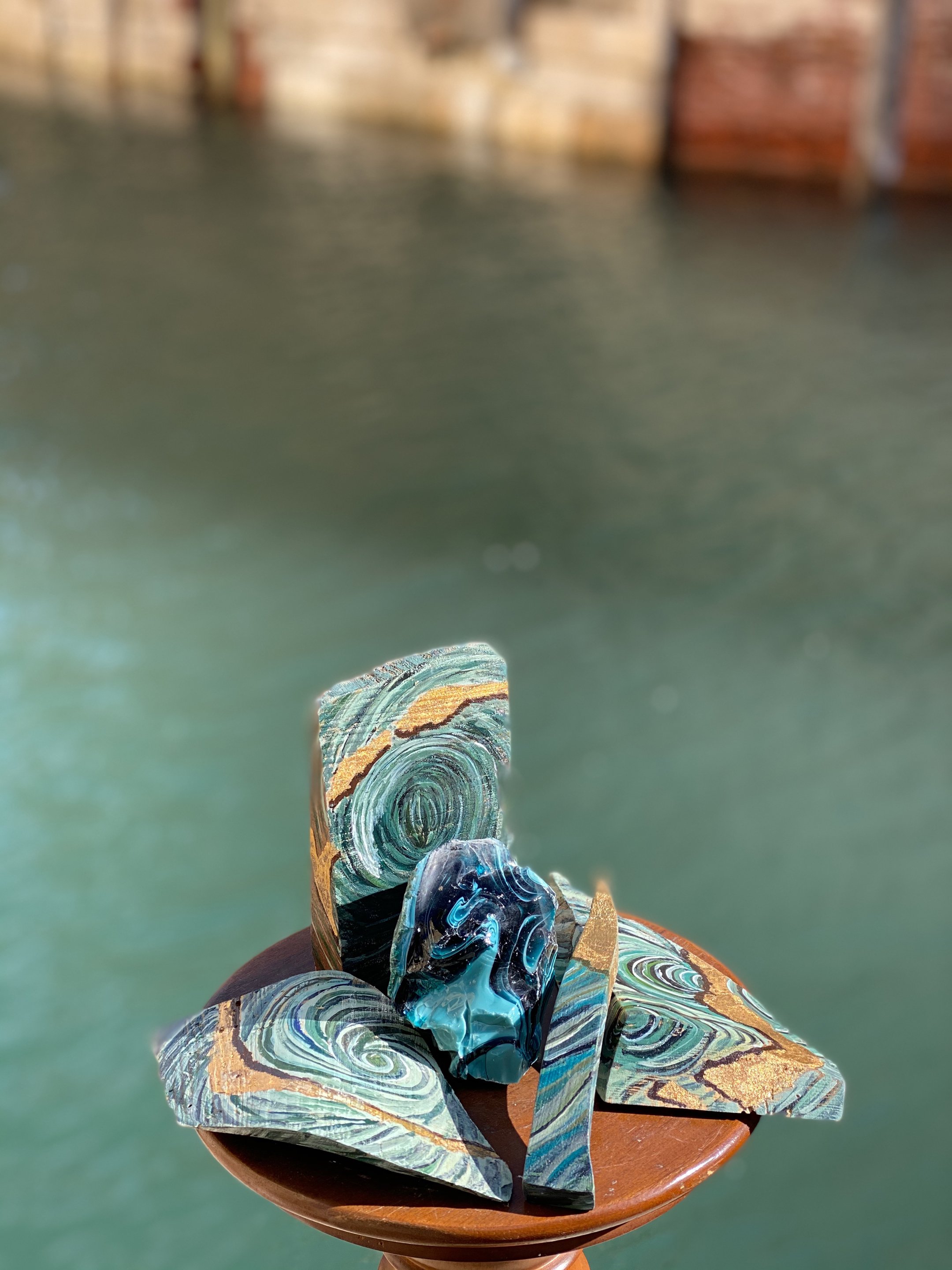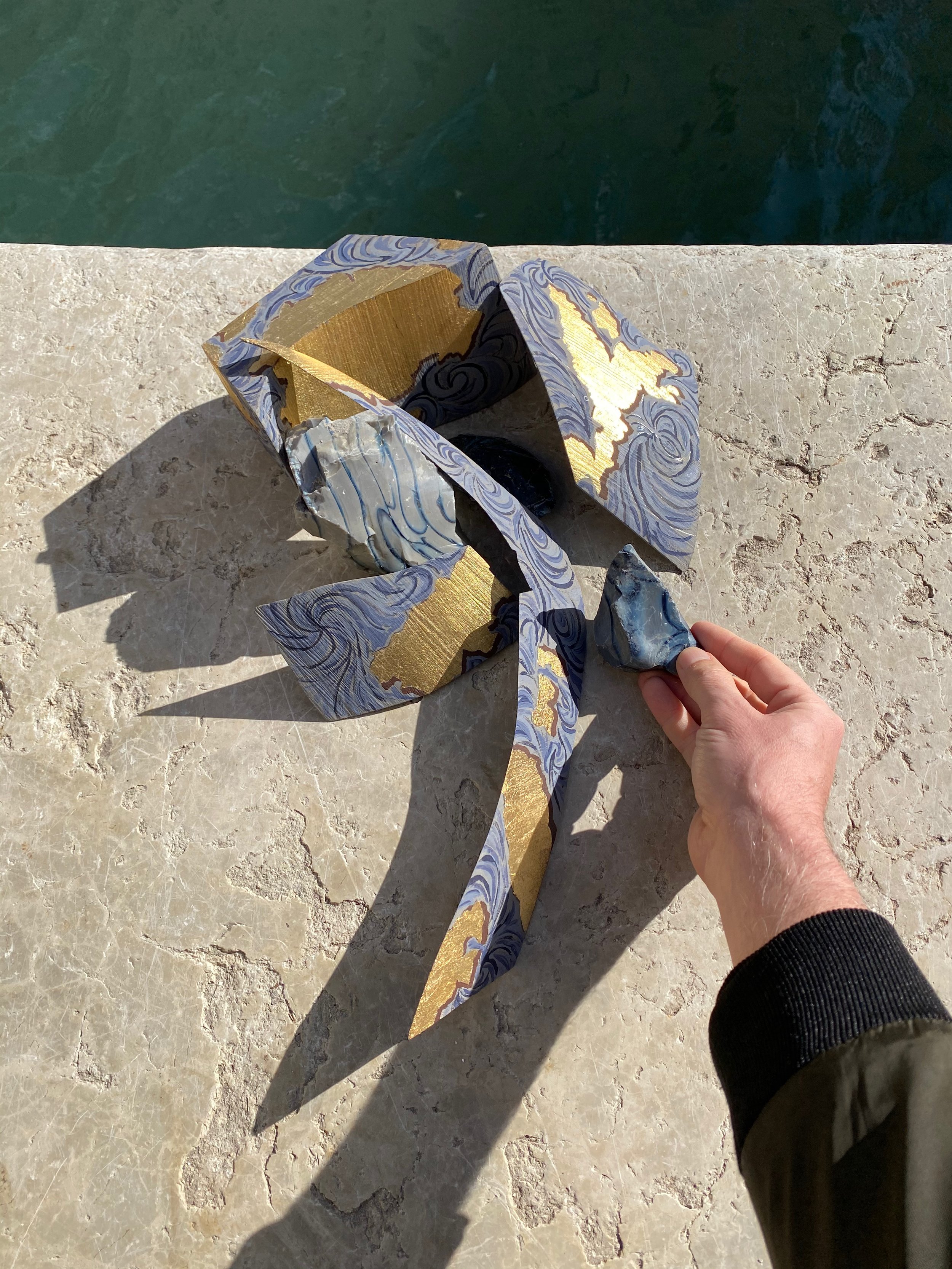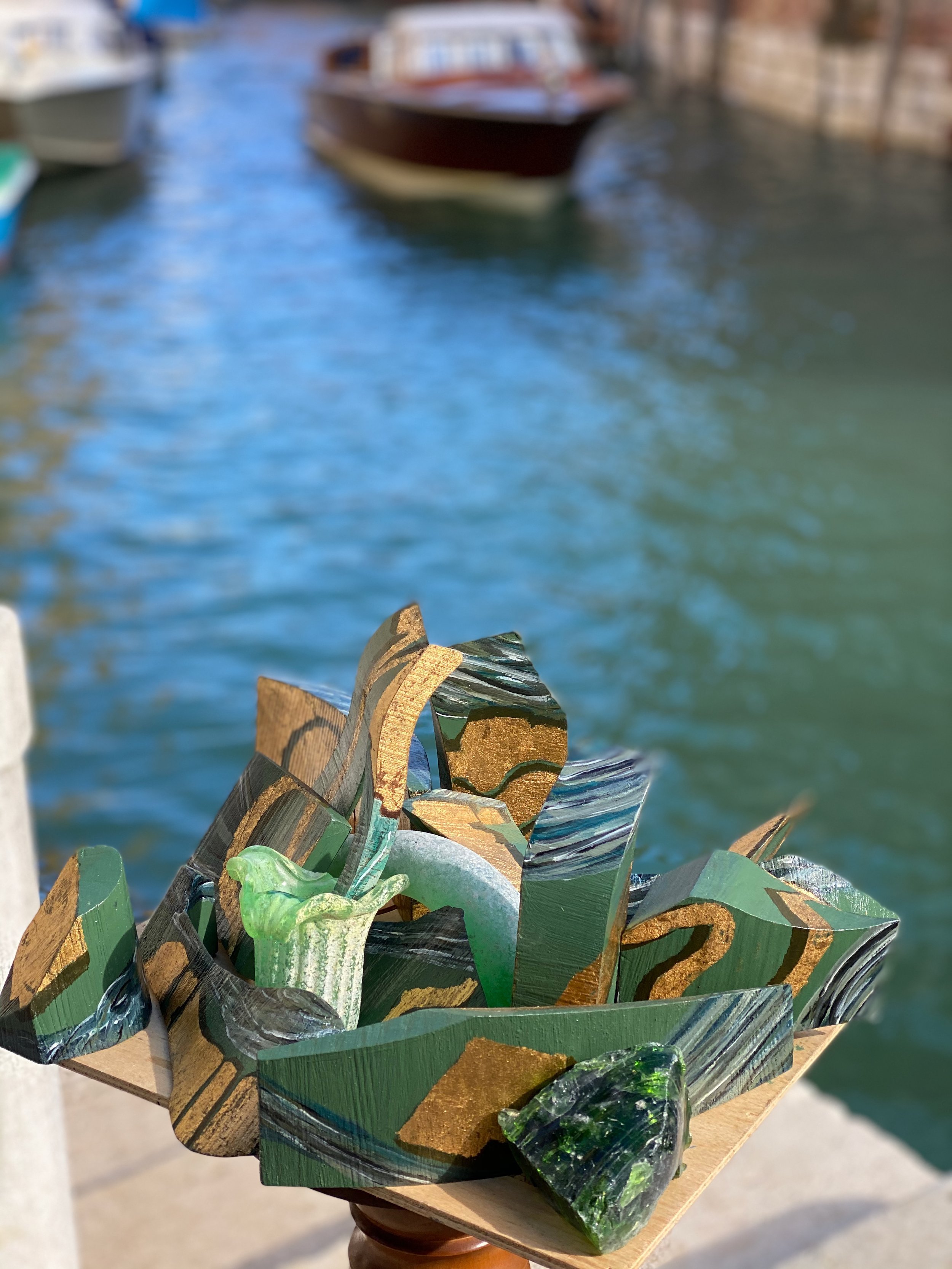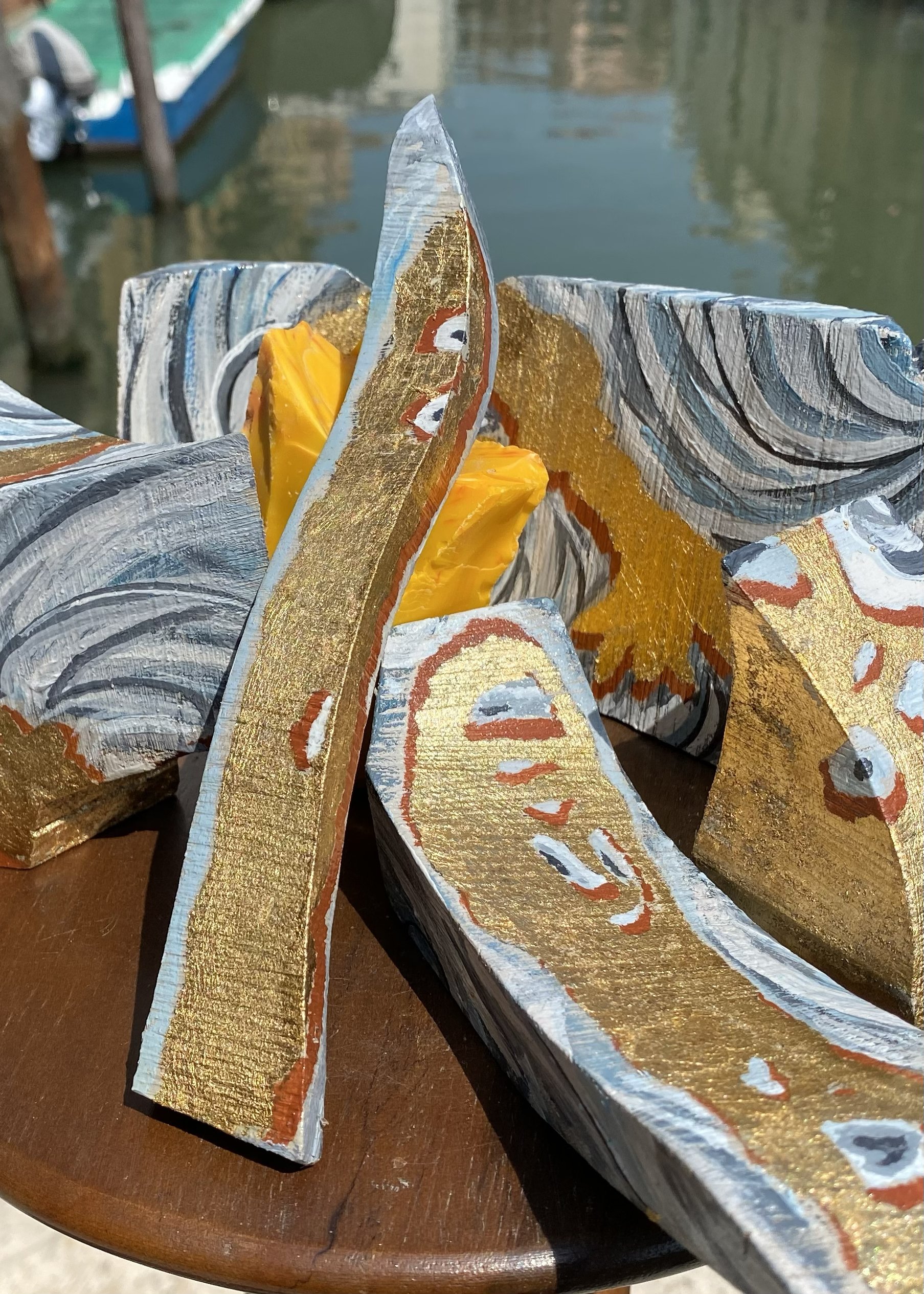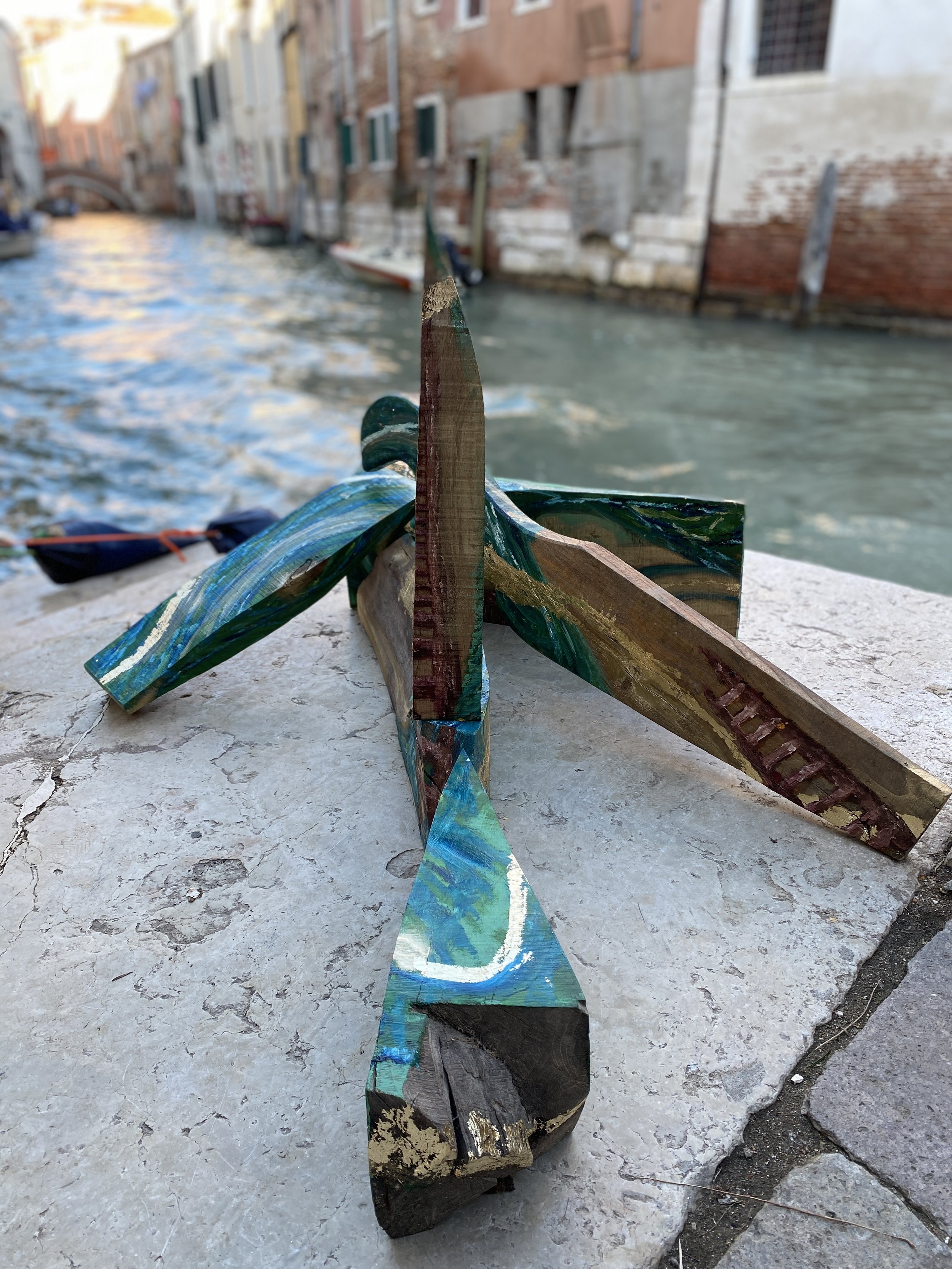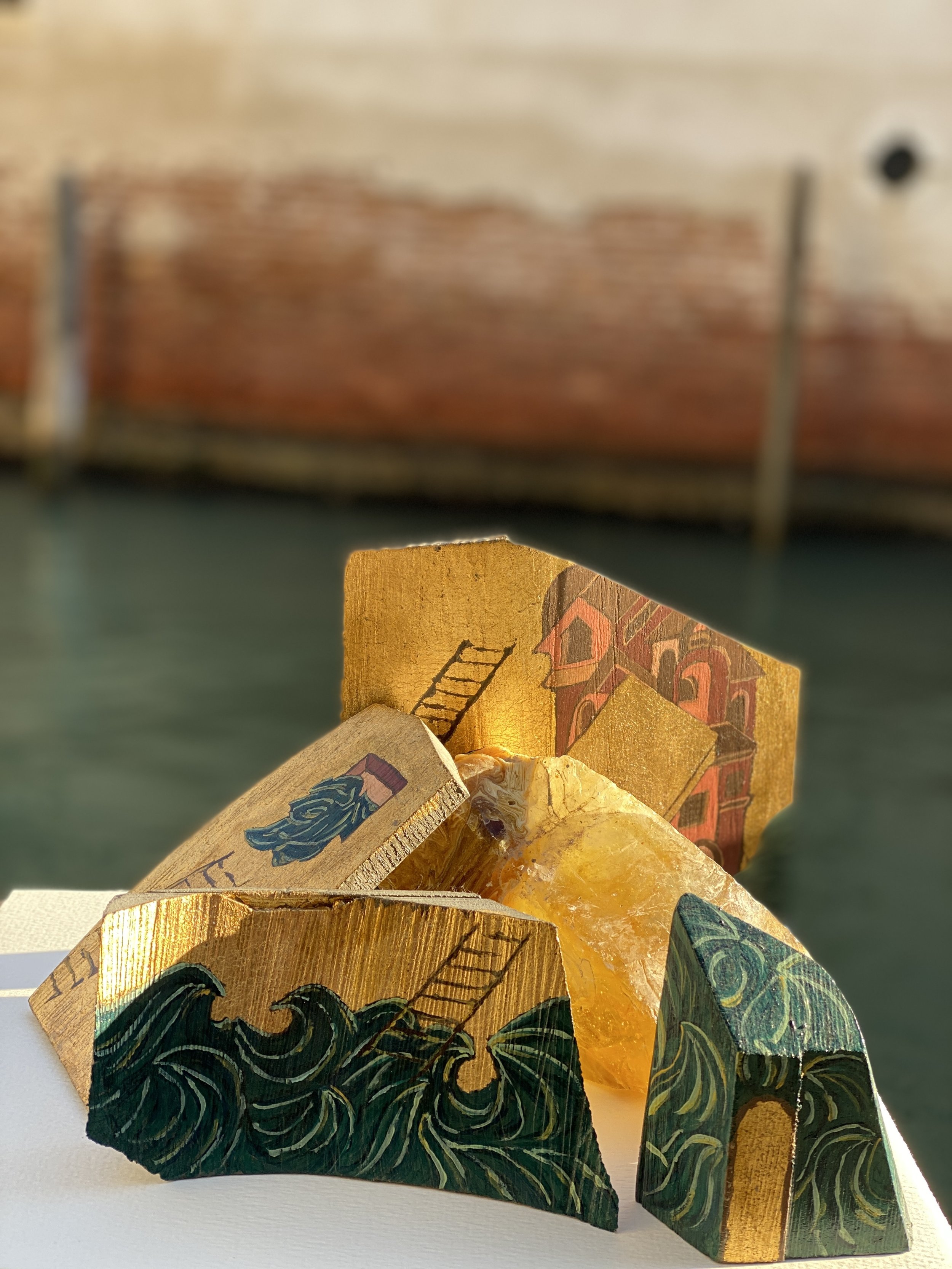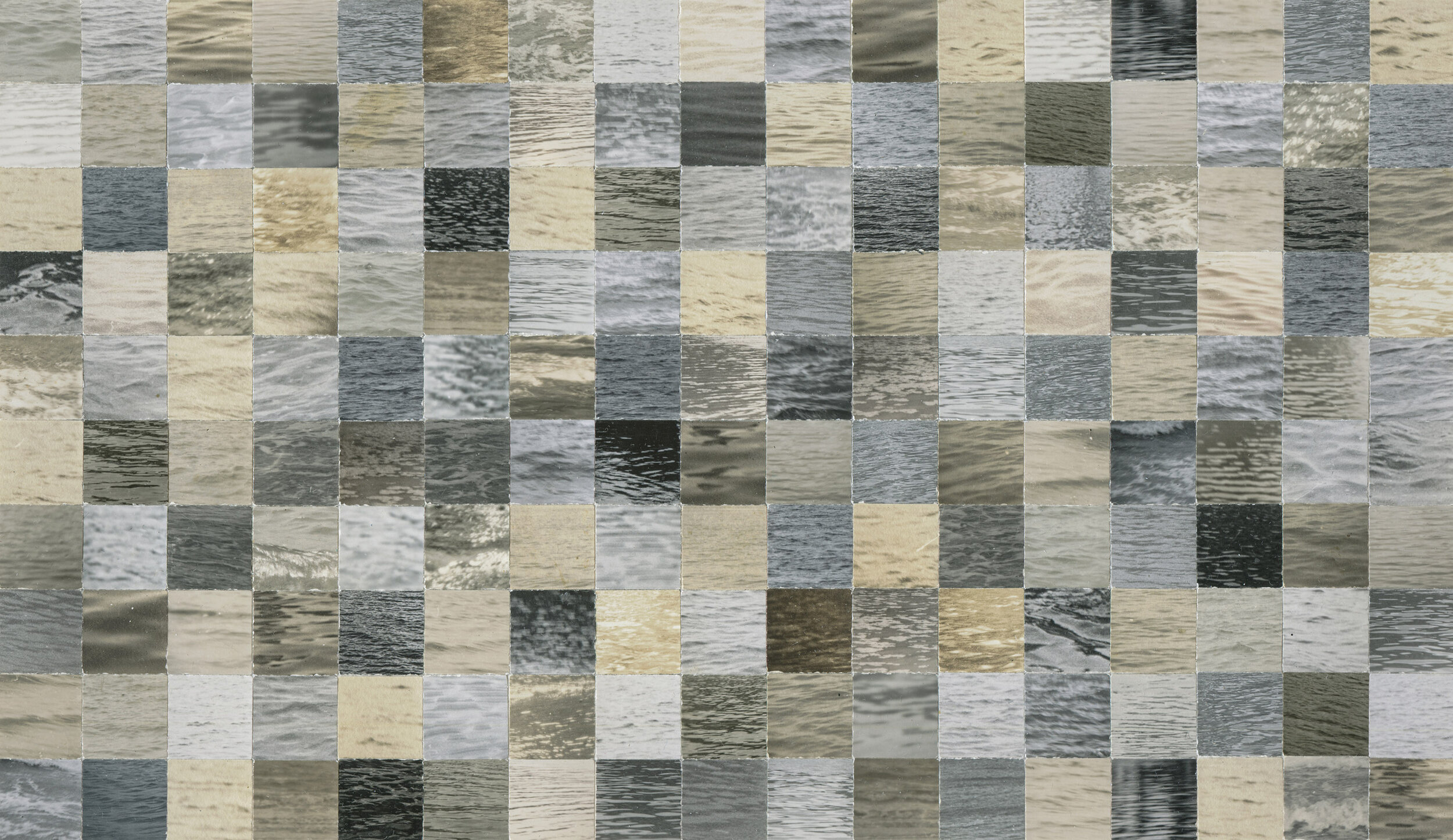Our Distance Became Water

Our Distance Became Water: Sculptures & Paintings at Ca’ Pisani, Venice
Looking back on an exhibition by Andreas Philippopoulos-Mihalopoulos
Environmentally focussed artist Andreas Philippopoulos-Mihalopoulos’ solo Venice Biennale exhibition was a sensitive reflection on the climate crisis and pandemic through paintings and small sculptural installations made from embellished found materials.
Discarded wood after a gondola’s forcola has been carved; gold leaf turned into maps of precarious islands at risk of sinking; found cullets of Murano glass; pieces of string that become celestial ladders: these are the materials the artist uses to tackle issues of climate change, social distancing, but also the melancholy of a future promise, and the illusion of a better world outside.
Deeply Venetian in material and spirit, the works seen here were produced in the city before and during the pandemic. The title of the exhibition recalls that sense of emptiness and distance that separated us at the height of the pandemic, but that also exists today as we journey through the environmental collapse. Water fills that distance, appearing both as promise and threat – what sustains us might also drown us. Here, the artist has opened a dialogue with the primary elements of the Venetian capital, itself a symbol of all precarious islands on which the effects of climate change are felt.
Text by Gavin Keeney
Written at the time of the exhibition
A great sinking feeling. Something is going down. A distress signal from elsewhere or here and now, and abject foreboding. It hardly matters which. The foregrounding of elemental forms, gilded vistas, precarious ladders to nowhere. Utopia lost again – and always a pretension anyway, for the most part. We can hear idealists raving at the moon while darkness falls over the human condition. Predicaments and presentiments. Portents for sinking into gloom while nonetheless climbing – or claiming to climb. Entropy under duress (and produced under duress), while trying nonetheless to ascend and escape – or due to the very fact of trying to ascend without duress.
Installation views at Ca' Pisani
It all causes pain in the heart, numbness in the brain. It is almost the proverbial artwork as heart-attack machine. Some ladders seem to have fallen, others pass through or stand in aqueous settings, or pierce jellyfish, blackness, with the odd trace or vestige of geometry barely discernible suggesting it is all occurring inside a glass structure, a crystalline city, or some now-preternatural gallery in Venice. Venice as preternatural gallery.
Amidst suspended or floating forms, some cubic and ominous, with string tethers suggesting ropes and pulleys, the ladders mostly climb skyward while falling. Yet they narrow as they rise. Some have fallen over. Others appear to be bleeding.
Sinking City XXII (detail)
Sinking City XXII (detail)
Direction Interrupted
There is no human presence here. “Man(un)kind” has been erased. Only De Chirico-esque illusionism and disillusion remain, perhaps an evocation of the end of pictorial pretensions and the onset of a world of empty and/or broken promises. Renaissance perspective implodes. Flotsam and jetsam of heart and mind, some might say – brain on overload and autopilot, others might say. Yet the artist is present, even if he has invoked remembered self-dissolution and the absence of human agency other than ruins and perspectival chaos.
The sculptures and the paintings tend to argue with one another. The sculptures are fashioned from bits of decaying wood from long-gone Venetian gondolas, or cast-off pieces in the construction of Venetian gondolas, plus pieces of discarded Murano glass. The wood is painted in such a fashion that it becomes “jewel-like” and in most cases “tied” by family resemblance to the fragments of glass. The primary edge, if one exists, is in the assemblage of such detritus – made more precious by presentation in a vitrine – in association with the paintings as “backdrop.” Many of the paintings, however, are also assemblages, and the comparison soon breaks down in terms of any aesthetic conclusions other than that they clearly agree to disagree. Perhaps it is the beauty of the painted wood and glass assemblages that saves something only apparently lost across the “landscape” of these works as reports on a condition approaching a lost cause. Best then to leave them to argue amongst themselves before they are dispatched to different places and to different collections associated with the art world and its penchant to commodify into oblivion such conversations that have little or nothing to do with evaluation as artworks.
Gavin Keeney, PhD
AGENCE 'X' / OOI-MTA+++
artist, theorist, author
The Artist: on Process
Picking up the pieces of discarded wood is an exercise in negative space. The gondola-maker, a man of solid tradition, trained in the Venetian art of gondola, oar and forcola (the oar-stand) making, cannot understand my fascination with these useless pieces of wood. He has no idea about the forms of that space he creates unwittingly, that surround the forcola or the oar but do not belong to it. Humble enablers of the proud Venetian form, destined to be discarded once the form emerges from them. Once I pick them up, I assemble them into compositions, imagining all the while the island map that will be grafted on them, the waves that will engulf it, the light that will be reflected on their surfaces, the shadows that will be casting onto each other.
I sand and treat the wood but I do not alter the forms. I need to work with what I have. I am not interested in giving form to matter, but to abandon myself to a negative material form, the accident, the minor. Once the surface is prepared, I begin with the layering of the egg tempera, a slow, deliberate, one-layer stratification of watery movement. The gold leaf is placed at the end, once all egg tempera has been laid on the wood. The maps of the islands are impressionistic but cartographic. The waves and vortices follow the currents of the pacific or the whirls of the Venetian lagune. Or perhaps the black Atlantic, where slave ships sunk and communities of half-human half-aquatic creatures emerged over the centuries, inhabiting a space no longer affected by the rising waters of climate meltdown.
Venice is the western symbol of what the islands in the pacific are dealing with.
Above: Sinking Islands: Funafuti, Fiji, Venice, Kiribati
I then match these with found Murano glass pieces, discarded by the Murano glass blowers once the ovens are cleaned. The pieces are like rocks, a geology of the Anthropocene where we create our own strata. The Earth’s surface covered in glass: beautiful but destructive for everyone and everything on the planet. A transparent metaphor perhaps.
The pieces have no set order or structure. I have often invited people to come and play with them – to jenga them up – till they save those flat inundated cartographies. Flirt with the vertical as much as gravity allows them. And watch them tumble.
Sinking City XXI
These nine compositions are surrounded by twelve paintings, once again treating water, islands, isolation. But this time, the vertical is more pronounced: stepladders populate the space between water and, what? more water? upper geometry? a pulsating huge jellyfish? The Byzantine references of the Heavenly Staircase at Saint Catherine on Mount Sinai end here. Stepladders here work only as a promise of a way out, a promise of higher and better, but a promise never delivered. The stepladder turns into a Babel of hubris. We cannot combat the planetary horizontality with more verticality. It is our verticality that has led to the collapse. Let’s lie down, flat and horizontal for a moment, let’s just listen to the lapping waters.
Andreas Philippopoulos-Mihalopoulos is a visual and performance artist, theorist, academic and fiction author, living between London and Venice. His work was also presented at the 58th Venice Biennale of Art 2019, the 16th Venice Architecture Biennale 2016, Tate Modern, MAAT Lisbon, Inhotim Instituto de Arte Contemporânea Brazil, Arebyte Gallery, Danielle Arnaud, ADAM, the Metaverse Virtual Biennale 2021, and more.
Two related water-themed exhibitions still on show in Venice
Lara Fluxà
Lara Fluxà’s project LLIM (Silt), at the Catalan pavilion, is an organism that temporarily displaces water from the Canal di San Pietro. Via a tubular glass network, canal water circles the gallery space, leaving behind evidence of its passage. Water and glass, two idiosyncratic materials that have played a key role in Venice’s history, become inseparable with this installation; two sides of the same landscape, both natural and cultural.
Dineo Seshee Bopape
Dineo Seshee Bopape’s immersive installation at Ocean Space (part of the series The Soul Expanding Ocean) is “a further step in her practice towards the marriage of the earth and the memory of the Ocean.” This dreamlike three channel film is both a physical and investigative journey for the artist, presented within the church of San Lorenzo.
Text above © Andreas Philippopoulos-Mihalopoulos & Gavin Keeney | Images by the artist & David Cass | Produced for A La Luz, 2022 | Please do not re-publish any of the above without prior written consent








